Kia Carens: Rear Seat / Rear Seat Frame Assembly Repair procedures
[Second row seat assembly]
| (Except Europe and Australia) |
| • |
Put on gloves to protect your hands.
|
|
| • |
When prying with a flat-tip screwdriver, wrap it with protective
tape, and apply protective tape around the related parts, to
prevent damage.
|
| • |
Use a plastic panel removal tool to remove interior trim pieces
to protect from marring the surface.
|
| • |
Take care not to bend or scratch the trim and panels.
|
|
| 1. |
Remove the rear seat back cover [LH].
(Refer to Rear Seat - "Rear Seat Back Cover")
|
| 2. |
Remove the rear seat cushion cover.
(Refer to Rear Seat - "Rear Seat Cushion Cover")
|
| 3. |
After loosening the mounting screws, then remove the rear seat cushion
inside inner cover (A).
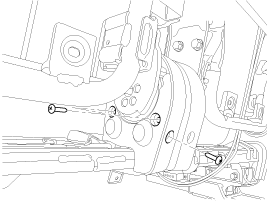
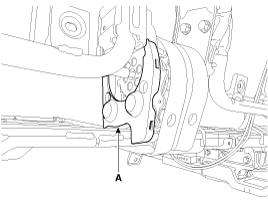
|
| 4. |
Folding the rear seat back assembly[LH].
|
| 5. |
Remove the rear seat cushion inside outer cover (A).
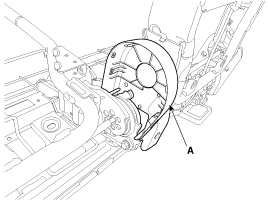
|
| 6. |
Remove the tether anchor garnish (A).
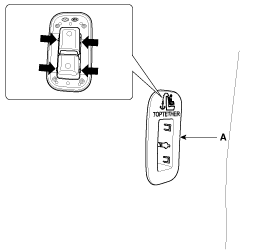
|
| 7. |
Remove the rear seat back board (A).
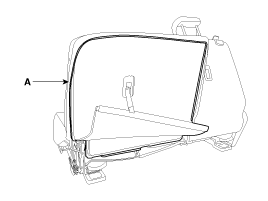
|
| 8. |
After loosening the mounting bolts, then disconnect the rear seat back
frame assembly (A) and rear seat cushion frame assembly (B).
|
Tightening torque :
44.1 ~ 53.9 N.m (4.5 ~ 5.5 kgf.m, 32.5 ~ 39.8 lb-ft)
|
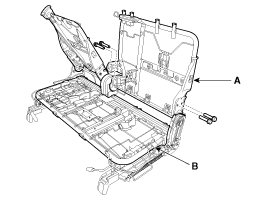
|
| 9. |
Install in the reverse order of removal.
| •
|
Replace any damaged clips.
|
|
|
| • |
Put on gloves to protect your hands.
|
|
| • |
When prying with a flat-tip screwdriver, wrap it with protective
tape, and apply protective tape around the related parts, to
prevent damage.
|
| • |
Use a plastic panel removal tool to remove interior trim pieces
to protect from marring the surface.
|
| • |
Take care not to bend or scratch the trim and panels.
|
|
| 1. |
Remove the rear seat back cover [RH].
(Refer to Rear Seat - "Rear Seat Back Cover")
|
| 2. |
Remove the rear seat cushion cover.
(Refer to Rear Seat - "Rear Seat Cushion Cover")
|
| 3. |
Remove the tether anchor garnish (A).

|
| 4. |
Remove the rear seat back board (A).
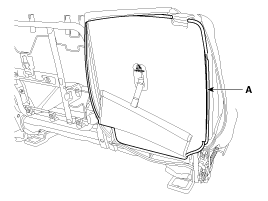
|
| 5. |
After loosening the mounting bolts, then disconnect the rear seat back
frame assembly (A) and rear seat cushion frame assembly (B).
|
Tightening torque :
44.1 ~ 53.9 N.m (4.5 ~ 5.5 kgf.m, 32.5 ~ 39.8 lb-ft)
|
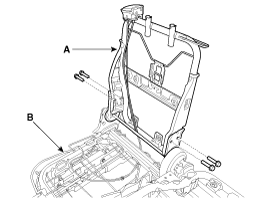
|
| 6. |
Install in the reverse order of removal.
| •
|
Replace any damaged clips.
|
|
|
| (Except Europe and Australia) |
| • |
Put on gloves to protect your hands.
|
|
| • |
When prying with a flat-tip screwdriver, wrap it with protective
tape, and apply protective tape around the related parts, to
prevent damage.
|
| • |
Use a plastic panel removal tool to remove interior trim pieces
to protect from marring the surface.
|
| • |
Take care not to bend or scratch the trim and panels.
|
|
| 1. |
Remove the rear seat back cover [LH].
(Refer to Rear Seat - "Rear Seat Back Cover")
|
| 2. |
Remove the rear seat cushion cover [LH].
(Refer to Rear Seat - "Rear Seat Cushion Cover")
|
| 3. |
Remove the tether anchor garnish (A).
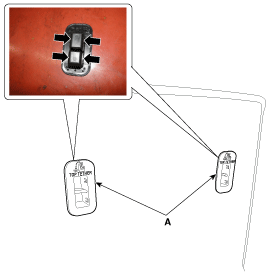
|
| 4. |
Remove the rear seat back board (A).
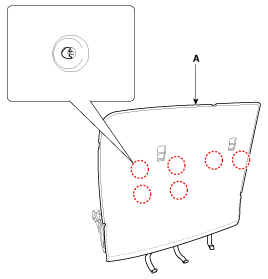
|
| 5. |
After loosening the mounting bolts, then disconnect the rear seat back
frame assembly (A) and rear seat cushion frame assembly (B).
|
Tightening torque :
44.1 ~ 53.9 N.m (4.5 ~ 5.5 kgf.m, 32.5 ~ 39.8 lb-ft)
|
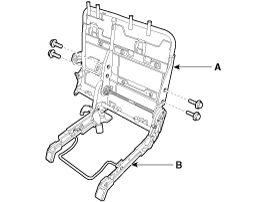
|
| 6. |
Install in the reverse order of removal.
| •
|
Replace any damaged clips.
|
|
|
| • |
Put on gloves to protect your hands.
|
|
| • |
When prying with a flat-tip screwdriver, wrap it with protective
tape, and apply protective tape around the related parts, to
prevent damage.
|
| • |
Use a plastic panel removal tool to remove interior trim pieces
to protect from marring the surface.
|
| • |
Take care not to bend or scratch the trim and panels.
|
|
| 1. |
Remove the rear seat back cover [RH].
(Refer to Rear Seat - "Rear Seat Back Cover")
|
| 2. |
Remove the rear seat cushion cover [RH].
(Refer to Rear Seat - "Rear Seat Cushion Cover")
|
| 3. |
Remove the tether anchor garnish (A).
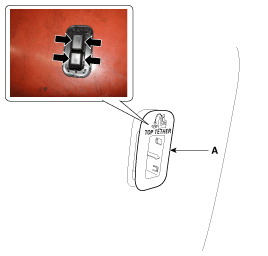
|
| 4. |
Remove the rear seat back board (A).
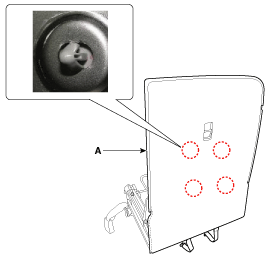
|
| 5. |
After loosening the mounting bolts, then disconnect the rear seat back
frame assembly (A) and rear seat cushion frame assembly (B).
|
Tightening torque :
44.1 ~ 53.9 N.m (4.5 ~ 5.5 kgf.m, 32.5 ~ 39.8 lb-ft)
|
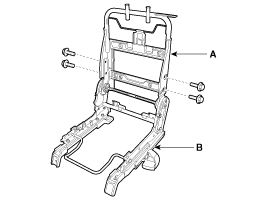
|
| 6. |
Install in the reverse order of removal.
| •
|
Replace any damaged clips.
|
|
|
| (For Europe and Australia) |
| • |
Put on gloves to protect your hands.
|
|
| • |
When prying with a flat-tip screwdriver, wrap it with protective
tape, and apply protective tape around the related parts, to
prevent damage.
|
| • |
Use a plastic panel removal tool to remove interior trim pieces
to protect from marring the surface.
|
| • |
Take care not to bend or scratch the trim and panels.
|
|
| 1. |
Remove the rear seat back cover.
(Refer to Rear Seat - "Rear Seat Back Cover")
|
| 2. |
Remove the rear seat cushion cover.
(Refer to Rear Seat - "Rear Seat Cushion Cover")
|
| 3. |
Remove the tether anchor garnish (A).

|
| 4. |
Remove the rear seat back board (A).
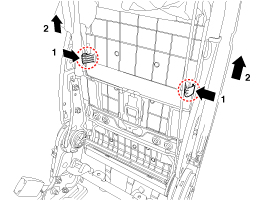
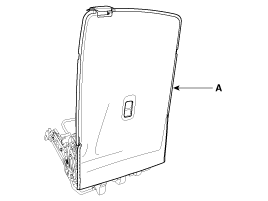
|
| 5. |
After loosening the mounting bolts, then disconnect the rear seat back
frame assembly (A) and rear seat cushion frame assembly (B).
|
Tightening torque :
44.1 ~ 53.9 N.m (4.5 ~ 5.5 kgf.m, 32.5 ~ 39.8 lb-ft)
|
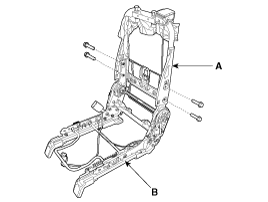
|
| 6. |
Install in the reverse order of removal.
| •
|
Replace any damaged clips.
|
|
|
[Third row seat assembly]
| • |
Put on gloves to protect your hands.
|
|
| • |
When prying with a flat-tip screwdriver, wrap it with protective
tape, and apply protective tape around the related parts, to
prevent damage.
|
| • |
Use a plastic panel removal tool to remove interior trim pieces
to protect from marring the surface.
|
| • |
Take care not to bend or scratch the trim and panels.
|
|
| 1. |
Remove the rear seat back cover.
(Refer to Rear Seat - "Rear Seat Back Cover")
|
| 2. |
Remove the rear seat cushion cover.
(Refer to Rear Seat - "Rear Seat Cushion Cover")
|
| 3. |
After loosening the mounting bolts, then disconnect the rear seat back
frame assembly (A) and rear seat cushion frame assembly (B).
|
Tightening torque :
44.1 ~ 53.9 N.m (4.5 ~ 5.5 kgf.m, 32.5 ~ 39.8 lb-ft)
|
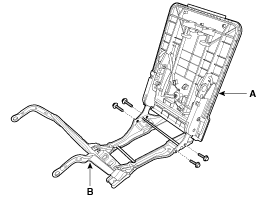
|
| 4. |
Install in the reverse order of removal.
| •
|
Replace any damaged clips.
|
|
|
Component Location
[Second row seat assembly]
(Except Europe and Australia)
[5-seat vehicle]
1. Rear seat back frame assembly
[ ...
Other information:
Front seat
(1) Forward and backward
(2) Seatback angle
(3) Seat cushion height (Driver’s seat)
(4) Lumbar support (Driver’s seat)*
(5) Seat cushion extension*
(6) Headrest
2nd row seat
(7) Forward and backward
(8) Seatback angle and folding
(9) Walk-in seat lever*
(10) Headrest
(11) Center seat ...
Wiper Setting Position Calibration Mode (Teach-In)
; If the assembled wiper arm is not lined up with the mark on the windshield,
activate the opposite electronic motor wiper arm and set the blade setting position
in teach-in mode to move the wiper arm to the correct position.
1 ...
 Rear Seat Frame Assembly Components and components location
Rear Seat Frame Assembly Components and components location Front Seat Belt
Front Seat Belt





















